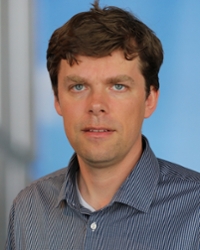Reinout van Weeren
Associate professor/Master Program Director
- Name
- Dr. R.J. van Weeren
- Telephone
- +31 71 527 5801
- rvweeren@strw.leidenuniv.nl
- ORCID iD
- 0000-0002-0587-1660

Reinout van Weeren's main research interest is in studies of galaxy clusters and large scale structures with the aim of understanding their origin and evolution.
More information about Reinout van Weeren
News
-
 Dust inhibits shock wave in iconic group of galaxies
Dust inhibits shock wave in iconic group of galaxies -
 Dutch astronomers observe giant jets emanating from black hole
Dutch astronomers observe giant jets emanating from black hole -
 Three new Programme Directors at the Science Faculty
Three new Programme Directors at the Science Faculty -
 Radio astronomers bypass disturbing Earth's atmosphere with new calibration technique
Radio astronomers bypass disturbing Earth's atmosphere with new calibration technique -
 Black holes are sometimes gigantic volcanoes. Martijn Oei earned his PhD on the subject, with honours
Black holes are sometimes gigantic volcanoes. Martijn Oei earned his PhD on the subject, with honours -
 LOFAR antennas unveil giant glow of radio emission surrounding cluster of galaxies
LOFAR antennas unveil giant glow of radio emission surrounding cluster of galaxies -
 Clusters of galaxies better in view with radio X-ray combination
Clusters of galaxies better in view with radio X-ray combination -
 Astronomers find largest radio galaxy ever
Astronomers find largest radio galaxy ever -
 A much sharper picture of the universe with new algorithms and supercomputers
A much sharper picture of the universe with new algorithms and supercomputers -
 Volcanic ‘activity’ in black holes blows monumental bubbles of hundreds of thousands of light-years
Volcanic ‘activity’ in black holes blows monumental bubbles of hundreds of thousands of light-years -
 Auroras on nineteen stars hint at hidden exoplanets
Auroras on nineteen stars hint at hidden exoplanets -
 Astronomers publish map showing 25,000 supermassive black holes
Astronomers publish map showing 25,000 supermassive black holes -
 Astronomers see gigantic collisions of galaxy clusters in young universe
Astronomers see gigantic collisions of galaxy clusters in young universe -
 Media about hundreds of thousands of unknown galaxies
Media about hundreds of thousands of unknown galaxies -
 Clashing galaxy clusters and extreme energies
Clashing galaxy clusters and extreme energies -
 Five ERC Starting Grants for young Leiden University researchers
Five ERC Starting Grants for young Leiden University researchers -
 Two Vidi's at Sterrewacht
Two Vidi's at Sterrewacht
Links
PhD candidates
Reinout van Weeren's main research interest is in studies of galaxy clusters and large scale structures with the aim of understanding their origin and evolution.
Galaxy clusters are the largest gravitationally bound objects in the Universe. They form through accretion of gas and via mergers with other clusters and galaxy groups. Clusters are unique laboratories to study some of the most fundamental questions in astrophysics, related to the physics of particle acceleration and cosmic rays, the growth of large-scale structure, and the nature of dark matter.
An important aim is to determine how the mergers between galaxy clusters lead to the acceleration of cosmic rays to relativistic energies. This is done by observing galaxy clusters with large radio telescopes and X-ray satellites. The LOFAR radio telescope plays a very important role in these studies by obtaining deep images of the entire northern sky. This allows detailed studies of individual nearby clusters and the discovery of very distant systems.
Associate professor/Master Program Director
- Faculty of Science
- Leiden Observatory
- Leiden Observatory


